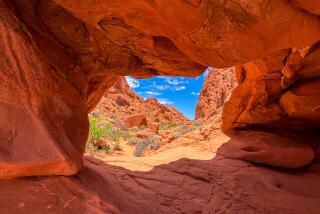Kartchner Caverns Could Be Cash Cow for Arizona
- Share via
TUCSON, Ariz. — It’s called the world’s longest “soda straw”--a stalactite 21 feet tall and a quarter-inch in diameter. Another crystalline column stands 55 feet tall in the same chamber, known as the Throne Room.
The public will come to know them and a raft of other ancient geological gems hidden in four naturally formed underground vaults when Kartchner Caverns State Park opens in November.
Arizona’s newest attraction is expected to lure thousands of snowbirds and residents from around the state. Some projections say the park will pump millions of tourism dollars into the economies of Benson, Sierra Vista, Cochise County and southeastern Arizona.
The figure could range from more than $7 million to $17 million in the first year and could climb from there, officials say.
Arizona State Parks officials originally estimated 150,000 people would visit annually.
“We have upped that number to 250,000 to 350,000. The parks system is realizing that 150,000 is a fairly conservative number, and they’ve looked at some ways of being able to channel more people through the caverns,” Kenneth Jones, director of the Cochise College Center for Economic Research, said.
That will translate into a windfall for all of Cochise County, particularly Sierra Vista and Benson, which is just 8 miles north of the park on Arizona 90, also dubbed the Kartchner Corridor.
The 2.4-mile-long caverns contain a mix of stunning limestone formations in colors ranging from brown and cream to shades of orange etched over eons by water trickling underground.
The state has spent more than $26 million since acquiring the caverns in 1988 to preserve and develop them for public viewing. It will cost a family of four at least $42 to do that, more than most other attractions in Arizona, including the Grand Canyon.
Larry Kreps, Benson’s community development director, said he expects big things. He showed off a photo of downtown during a recent economic forum where the caverns’ impact was discussed.
“This captures most of the exciting things happening in Benson, one picture,” he said. “I think it’s going to take many pictures to capture the essence of Benson in the future.”
Since November 1994, five hotels and a dozen restaurants, accounting for 240 new jobs, have opened along the highway and in Benson itself in anticipation of the caverns’ opening.
So have eight RV parks and two related stores.
And four months before entrances to the caverns open in the side of a Whetstone Mountains foothill, the restaurants and hotels are doing good business, Jones said.
Last year, visitors to Cochise County averaged stays of 2 1/2 days, with an average of 2.5 people per party spending an average of $127 a day, Jones said.
In contrast, day-only visitors from Phoenix, Tucson or elsewhere spent an average of $57 a day, he said.
As originally projected, visitors during the first year were expected to spend $7.3 million directly on tourism, Jones said. Those visitors would account for $11.7 million in total spending when multipliers are included, such as money local workers paid with tourist dollars will spend on goods and services.
Finally, those 150,000 visitors would bring the county $5.6 million in new money that would not have existed without the presence of Kartchner Caverns, Jones said.
With more visitors now anticipated, the totals increase significantly.
At 250,000 visitors, direct spending would amount to $12.2 million, total spending would equal $19.5 million and new money would nearly double to $10.5 million.
And 350,000 visitors annually would bring in $17.1 million in direct spending, $27.4 million in total spending and $15.4 million in new money.
As visitors increase, a greater percentage will come from outside Cochise County--perhaps 75% of 250,000 and about 80% of 350,000, Jones said.
A few years from now, that percentage is likely to be even more pronounced as the novelty of a new state park wears off for area residents, he said.
Eventually, he said, the draw of the caverns could mean increased relocations of both residents and businesses, similar to what has happened with Ft. Huachuca, Sierra Vista’s largest employer.
Development of the caverns offers a lot of opportunity for the county, “especially when you look at the new money being infused into the area,” Jones said. “It’s those new dollars that would have bypassed Cochise County and gone elsewhere.”
More to Read
Sign up for The Wild
We’ll help you find the best places to hike, bike and run, as well as the perfect silent spots for meditation and yoga.
You may occasionally receive promotional content from the Los Angeles Times.






